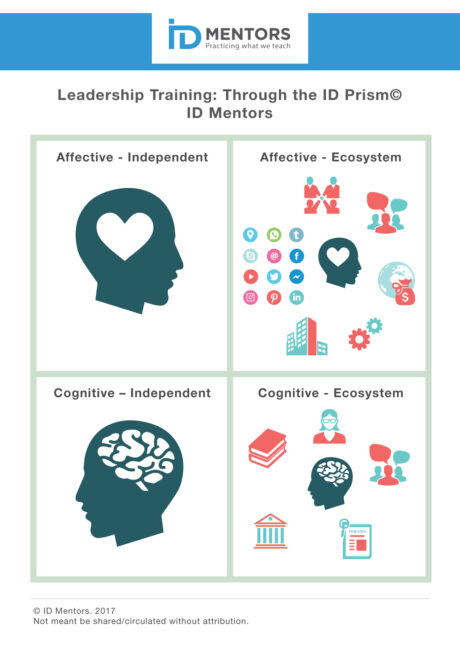
Overview
Just peruse a few Leadership Training programs and chances are that you will notice the following topics: Leadership Definition, Leadership Styles, Goal Setting, Performance Planning, and skills such as, Delegation, Negotiation, Time Management, Budgeting, Coaching and Communication.
You will also find a sprinkling of cherries in the form of a few examples and/or stories about BIG world leaders, such as Gandhi, Martin Luther King, Mandela, etc. OR business leaders, such as Steve Jobs, Jeff Bezos, Mark Zuckerberg, Narayana Murthy who scripted change.
Finally, for good measure, there may be a couple of role plays to provide participants with a hands-on experience of the skills involved. In short, most leadership training programs oscillate between two extremes – they are either about process-driven transactions in the workplace OR about changing the organization/landscape/world.
Instructional Design is about Context (versus Content)
Are leaders in a startup expected to act and behave in the same way as leaders in a big multinational setup that has been around for more than a decade; or are leadership traits the same in a consumer retail organization and say a Design Firm that is involved in creative work? What about culture? How does that impact leadership? Is it only about how to greet a person from another country when you meet him/her? Shouldn’t one focus upon challenges of leadership in a specific culture/context, and how to address these? Design Thinking helps you to focus on the context, and thereby to zero-in on 2 OR 3 critical competencies, which will significantly improve performance.
Instructional Design is about Insights (versus Transactions)
Think about this. You paste an artificial smile on your face and give “feedback” to your subordinate about his/her performance. You also start with a preamble – “please take this feedback constructively”. Chances are that the person will pick your intent – it is a scientifically established fact (mirror neurons). So if you mean well, the person at the receiving end will listen, learn and collaborate. But if he or she senses that there isn’t any genuine intent, the “feedback” session will just not work. Look at it this way – if the intent is genuine, a leader will not have to bother about words – he/she will automatically find the right words. Through Instructional Design you can identify such “insights”, and focus on these in your training as against, superficial stuff such as body language and the right words to choose.
Instructional Design is about Emotion (and not merely Cognition)
Leadership boils down to a series of social exchanges in which the leader can drive the other person’s emotions into a better or worse state (Goleman 2006, 276). Leadership touches the human spirit, and touching the human spirit has always been the work of art and aesthetics. It’s not surprising, therefore, that good leaders have always thought of leadership as more of an art than a science (Denhardt & Denhardt 2006, 175).
Instructional Design with its focus on learner and empathy will help you add such artistic elements to your training, which will strike a chord with your learners. For example, you could say what you are saying with a picture, instead of a thousand words and have a far reaching impact.
To conclude…..
“The biggest budget band for senior leadership is more than $1,000 per learner per year, with 58 percent of companies spending that much. Some 39 percent of companies spend $1,000-plus per high-potential employees. Only 17 percent spend that much annually per individual contributor. – Employee Training Institute, 2016”
https://trainingmag.com/top-spending-trends-training-2016-2017


0 responses on "Leaders are what they do; not what they say"